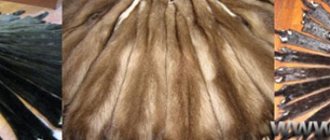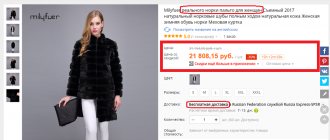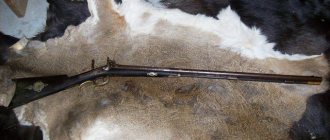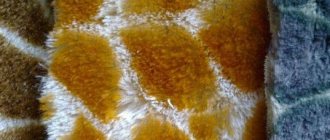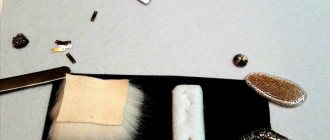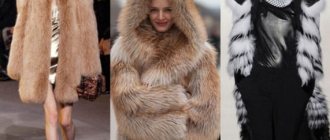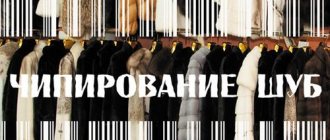Fur coats are one of the first product groups selected for tracking in a unified state system. Products made from natural fur were not chosen by chance, because it is in this product group that there is an increased level of counterfeit products. A high share of the shadow market in this niche belongs to Chinese manufacturers producing high-quality counterfeits.
Already on August 12, 2021, a program for mandatory labeling of products made from natural fur was launched in the Russian Federation. To control the movement of fur coats, KiZ identifiers were chosen. Outwardly, it resembles a regular label, but in fact it contains an RFID tag (chip), an individual number, material data and a 2D code. Thanks to KiZ, authorized bodies can control all movements of each product item, from the moment of its manufacture to sale to the end consumer. Previously, the main resource for labeling products made from natural fur was the tax.ru system. But as of June 1, 2019, the powers of the operator transferred to the CRPT and the IS “Chestny Znak” (CHZ).
When and why did they start marking fur coats?
By general agreement of the participating countries of the Eurasian Economic Union, a pilot project was launched on August 12, 2020, under which mandatory labeling of fur products was introduced in the EEC (agreement on the implementation of the project in 2015-2016).
On August 11, 2016, Decree No. 787 of the Government of the Russian Federation was signed on the procedure for implementing the project in Russia. It was called a pilot because it was initially introduced for one type of product - fur products. But chips on fur coats began to be mandatory back in 2021. Since 2021, it is required to label fur products through the Honest Mark system. Labeling allows you to track the origin of a product and its promotion on the market from the manufacturer to the buyer through all intermediaries, since the brand contains information about the product, formed in the form of a KIZ - a control identification mark of an approved sample. All movements of goods are recorded in the Honest Sign program until it is sold by the store. The buyer, using an ID (identification mark, brand, chip) through the website honestyznak.rf, has the opportunity to obtain the data he is interested in about the purchased product (brand, type of fur, country of origin, seller).
The innovation has rid the market of counterfeit products; the Federal Tax Service's labeling system for products made from natural fur allows you to track trade turnover and control the payment of taxes. The Federal Tax Service is not a marking operator; powers have been transferred to the national digital marking system Honest Sign. But the Federal Tax Service has developed convenient applications for verification.
Responsibility for lack of markings on a fur coat
From 2021, markings on fur coats made from mink, arctic fox, fox and other natural fur must be mandatory. For the production or sale of fur coats and other fur products without brands, administrative and criminal liability is provided. Administrative - fines under Art. 15.12 of the Code of Administrative Offenses of the Russian Federation in the amount of:
- for production: for officials - from 5,000 to 10,000 rubles, for legal entities - from 50,000 to 100,000 rubles;
- for implementation: for officials - from 5,000 to 10,000 rubles, for legal entities - from 50,000 to 300,000 rubles.
Items of the offense are confiscated. When producing or selling batches of fur products without brands, KIZ in a large amount (in the amount of 400,00 rubles or more), punishment is threatened under Art. 171.1 of the Criminal Code of the Russian Federation - from a fine in the amount of 300,000 rubles to imprisonment for up to three years with a fine. Criminal liability is assigned to officials of organizations.
Who is required to label fur coats?
KIZ is a control identification mark, it is a way to mark fur coats, strict reporting forms, which include protected graphic information (brand). KIZ is created not by the fur coat manufacturer itself, but by the Goznak joint-stock company at the request of the manufacturer (order of the Federal Tax Service of the Russian Federation No. SA-7-19-/ [email protected] dated 08/15/2016).
The decree of the Government of the Russian Federation does not directly answer the question of what the KIZ marking is, but from its provisions it is clear that this is the same marking.
There are three options for KIZ:
- sewn-in, when it is sewn into a structural element of the product, the brand remains visible;
- adhesive, in this case the KIZ is glued to a structural element of the fur coat;
- hinged, when the sign is attached to a loop of a fur coat.
All three come in two sizes and two colors. Green means that the product was produced on the territory of the EEC, red means that it was imported from abroad. KIZ standards are established by the EEC Agreement.
The manufacturer labels the products, then at each stage of resale of a batch of goods, a mark is made in the Honest Sign system (the manufacturer transmits a list of retired brands through the system according to the required reporting). After sale, the mark is indicated on the receipt, data about it is transmitted first to the fiscal data operator (the legal entity servicing cash registers and transmitting checks to the Federal Tax Service), and then to the labeling operator and the Federal Tax Service.
In accordance with the EEC Agreement, all fur coats made of natural fur, fur-lined products, parts and accessories of fur products, including muffs, collars, etc. are marked. Products with fur trim are not marked.
What the “Mobile SMARTS: KIZ” program can do
There are other software functions in the “Marking” system, namely:
- inventory;
- checking the functionality of the chip;
- relabeling;
- acceptance and shipment.
The program, immediately after applying a radar tag or a KIZ barcode, quickly determines the defect and allows you to verify the correctness of the recorded information. Reconciliation concerns information with the contents of the identifier. Once a discrepancy is identified, the tag can be quickly replaced. Due to this, the tax office receives only up-to-date information, so businessmen do not have to be afraid of audits.
Step-by-step instructions on how to connect to the system
The legislation does not contain an algorithm for the process, but in practice the following step-by-step instructions for labeling fur products are used:
Step 1. Registration in the system.
Step 2. Joining the GS1 RUS association is a prerequisite.
Step 3. Description of the product on the website of this association.
Step 4. Submitting an application to Goznak JSC for codes and paying for them.
Step 5. Receive the CIDs and install them on the product using one of the provided methods.
Algorithm of actions when registering in the system:
Step 1. Order and receive a qualified electronic signature (legal entities will need a strengthened one).
Step 2. Check the availability of the necessary software hardware on the computer and signature verification key certificates, and install them if necessary.
Step 3. Register in your personal account and set the correct value in your profile - participant in the “Marking” system.
How to obtain and register a unique code
First, the user will need to register in the Marking system. There, on your personal page, you fill out an application form for the production of an identifier.
You can select one of two types of labels: blank and individual. An individual tag initially contains information about the product, while a tag without individualization must be filled in manually, after which the information is transferred to the system.
The “Mobile SMARTS: KIZ” program transmits information about the new tag. The program must be installed on the RFID terminal or barcode scanner. Once the program is started, the tag is read by the device. Using the terminal, information is recorded on the label of a unique sign, and then the product becomes marked. As soon as the entire batch of goods is marked, the information is automatically transferred to an Excel table, which is sent to the system in a special file after data verification.
What's in a name
The most common mistake is incorrect indication of the product name. This column often indicates “product, fur coat, fur product,” and also lists the model, color, and at the same time the type of fur and size. But there is no need to duplicate the information in the “product name” paragraph. Special columns are provided for these characteristics.
The concepts of “fur coat”, “short fur coat” or “fur product” are absent in GOST 32084-2013. This kind of clothing includes: coats, short coats, jackets, suits, jackets, trousers, jackets, capes, vests, skirts and other similar products made from fur skins, their parts and flaps.
What is a control (identification) mark?
The characteristics of the KiZ, the procedure for its application, and the requirements for the information contained on it were approved by decision of the Council of the Eurasian Economic Commission dated November 23, 2015 No. 70 (posted on the Federal Tax Service website). According to this document, KiZ is a strict reporting form with security elements, made of textiles, paper or plastic. The control mark is frost-resistant and can withstand temperatures of –40 degrees Celsius and below.
There are three types of control signs: sewn-in, adhesive and overhead (hinged). Sewn-in KiZs are inserted into the seam during the production of the product, adhesive ones are applied to a special marking label (if available), and invoices are attached to a loop or hanger. Participants in the fur market have the right to choose which type of CIZ is preferable to them. Without exception, all control signs do not allow reuse, since disconnecting the CIZ from the marked product leads to damage to the sign. KiZ can be either red or green. A red mark is used to mark a product manufactured outside of Russia. Green signs mark domestic fur products.
Each control (identification) mark contains visually readable information. This includes, in particular, the short name of the product group. It is the same for all fur products and looks like “Products made from natural. fur." Plus, the sign indicates the 2-character code of the state that released the product into circulation (for Russia it is RU), and the KIZ identification number. In addition, each key contains information that can only be read using special devices. This is a radio frequency tag (RFID) tag that contains a serialized Global Trade Item Identification Number (SGTIN). This number can be applied by the fur market participant himself. There is another option - order a control plate from the manufacturer with the serial number already applied. Also, each KiZ has a linear barcode and a two-dimensional QR code.
The only company that produces control signs is the Perm Printing Factory, which is a branch of Gosznak JSC. Each participant in the fur market must enter into an agreement with the factory and order KiZ for their products. The cost is fixed and is: for sewn-in and adhesive signs - 15 rubles each. (including VAT), for an invoice (mounted) sign - 22 rubles. (including VAT).
Product labeling information system: results and prospects
It is more logical to speak about the national labeling system in the language of facts:
- Only the first year of the experiment on monitoring medicines made it possible to record offenses amounting to 500,000,000 rubles.
- The introduction of identification in the pharmaceutical industry stopped the resale of subsidized drugs under federal programs.
- Thanks to microchipping of fur coats, the Russian fur market has increased tenfold compared to 2021 figures.
- The experience of foreign countries allows us to count on a significant reduction in the number of counterfeit tobacco products. For example, in Brazil, the work of a similar system led to an increase in budget contributions by 40%.
When is KiZ needed and when is it not?
For those unaccustomed to reading complex legal texts, we offer the following simple rules:
Fur coat made entirely of natural fur - marking
Remember: it doesn’t matter at all what kind of fur the fur coat is made of. It could be a mink, an arctic fox, or a rabbit... It is pointless to give a complete list of unfortunate animals. The main condition for labeling is that the fur must be NATURAL!
You should not take into account what part of the fur coat is - the front or the back - fur. You still have to take care of the tag.
Item with fur trim - DO NOT mark
Colors of rainbow
If fur skins are dyed, then in the “color of the product” column you should indicate the name of the color assigned by the manufacturer according to the standard sample, with a decoding. If the color is not assigned by the manufacturer, then one of the colors of the rainbow should be used, indicating the intensity “dark” or “light” if necessary.
If the color of the skins in the product is natural, then you should use GOST standards for skins of a specific type of fur or fur, which regulate the color of a particular type of fur or fur by color or color group. You can also use a color scale for sorting skins from a particular auction. For example, indicate the group and name of the auction: brown group “STK”, brown group “scanglow”, blue group “sapphire”, “iris”.
Problems also arise with filling out the “dyed fur” column. Often for painted products they indicate “no”, which is not true and misleads the buyer. Dyed fur or furs will last much less than products in natural colors.
Products made from dyed skins are subject to more wear and tear during natural use than products made from natural colored skins.
In addition to dyeing, there are the concepts of “bleaching” and “tinting”. Which also informs the consumer about wear and tear periods. Manufacturers should indicate this in the labeling.
Results
The list of goods that are subject to mandatory labeling is approved by the Government of the Russian Federation. The transition to mandatory labeling occurs gradually, over a long period of time, with different labeling periods for different products and an established smooth transition period.
Sources:
- Federal Law of December 28, 2009 No. 381-FZ
- Order of the Government of the Russian Federation dated April 28, 2018 No. 792-r
You can find more complete information on the topic in ConsultantPlus. Free trial access to the system for 2 days.
Labeling fur products: what is the procedure
As already mentioned, manufacturers and importers are responsible for labeling their fur products. Manufacturers do this during the production process, and importers do this when entering the country. Absolutely any chip is unique, exists in a single copy, due to which the system always contains accurate information about the number of product items among fur coats or fur coats currently on sale. The movement of goods is fully monitored, all stages of the route are recorded when information is entered into the electronic document flow. Information about any step must be sent no later than 3 days.
To sell fur products with unique marks, a special RFID reader and software are required. In some cases, you can get by with a simple 2D scanner. This applies to cases where the manufacturer or importer uses tags with SGTIN codes.
In what cases is marking not necessary?
Clause 2 of the Labeling Rules lists operations with fur products for which there is no need to label the product. This includes, among other things, export outside the Eurasian Economic Union, transportation under customs control and sale in duty-free stores. In addition, this includes the delivery and storage of products intended for testing in the field of standardization and technical regulations, as well as the delivery and storage of exhibits from international exhibitions. This also includes the importation of free humanitarian aid into the country and operations for the confiscation, seizure and arrest of goods.
Labeling is also not required when the product is stored or used by the manufacturer itself, or when the products are used by individuals for personal purposes. Finally, delivery and storage of products returned by customers to the retailer with return documentation is not covered by labeling.
What applies to clothing subject to labeling?
Mandatory clothing labeling from 2021 raises many questions. Let's take a closer look at what applies to clothing that needs to be labeled.
As you can see, clothing labeling from 2021 is mandatory not for all clothing, but only for some of it. The same applies to mandatory labeling of children's clothing: not all children's clothing is subject to it, but only those listed in the table.
When determining whether clothing is included in the list of goods for labeling in 2021, it is necessary to be guided by the technical documentation for the product, and not its appearance. Manufacturers should carefully and as accurately as possible select the HS code and compare it with the codes specified in the order on mandatory labeling.
The procedure for labeling goods is described in detail in ConsultantPlus. Sign up for a free trial and find out the marking algorithm.
